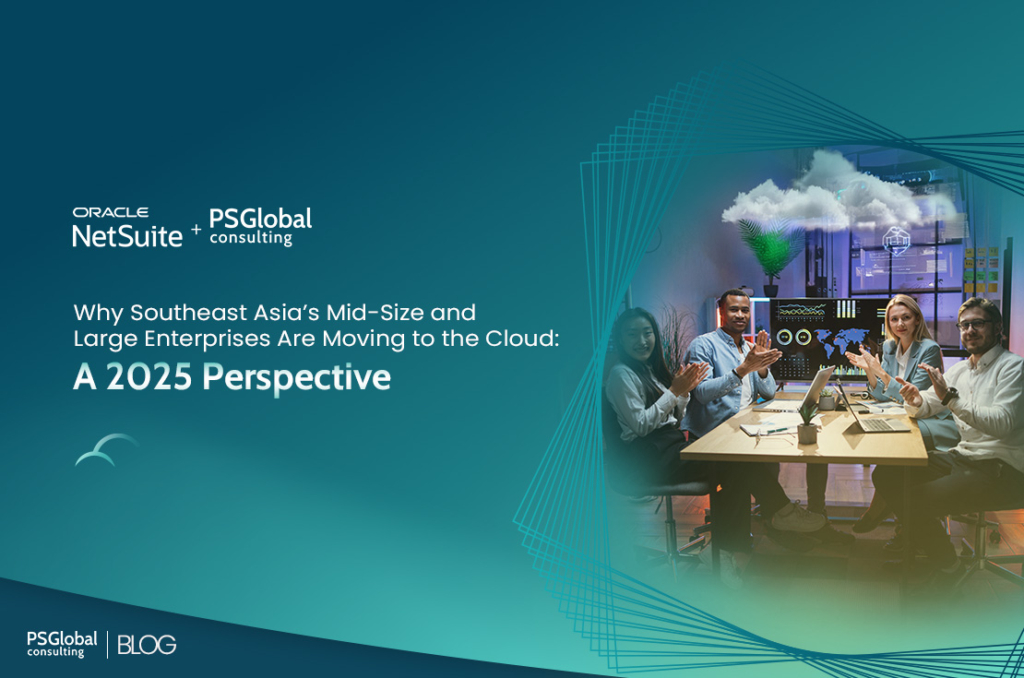Introduction
In 2025, Southeast Asia’s (Asean) digital economy’s value is projected to reach US$236 billion1. Advancements in artificial intelligence, personalised e-commerce experiences, and a growing need for digital trust and security fuel this growth. The Asean technology startup ecosystem is shifting its focus from rapid expansion to sustaining innovation through the adoption of AI, fintech, and regional scaling strategies as part of its ongoing digital transformations.
The widespread adoption of generative AI is central to the technological shift, allowing businesses to maintain competitiveness across various industries and enabling countries in the region to embed advanced technologies directly into their core business operations.
Cloud as the Backbone of Agility and Resilience
Agility, scalability, and resilience are essential for enterprise survival and growth in the current business landscape. Mid-sized and large Asean companies increasingly adopt cloud ERP systems to embed agility into their operations. This enables real-time decision-making, operational flexibility, and seamless cross-border scaling. Such tech-driven resilience is critical for navigating complex regulations, economic uncertainties, and evolving customer expectations.
Over 94% of enterprises globally leverage cloud services. The Asia-Pacific region is experiencing the most rapid growth in the cloud market, registering an 18.2% compound annual growth rate (CAGR). Leading cloud platforms include AWS, Azure, and GCP2. For Southeast Asian businesses, developing cloud adoption frameworks and multi-cloud strategies is essential to ensure regional flexibility and address geopolitical factors3.
Southeast Asia in Focus
Cloud adoption is rapidly accelerating among mid-size and large enterprises in Southeast Asia. The market was valued at US$208.8 billion in 2024 and is projected to reach US$512.5 billion by 20334. This growth is driven by post-pandemic digital acceleration, the rise of AI, increasing sustainability pressures, and intensifying regional competition. For mid-market companies, integrating cloud ERP has become essential for building agility and resilience directly into their business models.
Thailand
The Thailand Board of Investment (BOI) incentivises digital transformation, leading to a projected 19.5% CAGR in cloud adoption by 2025 and a THB4.69 trillion digital economy. Manufacturers and retailers are accelerating cloud migrations, with public cloud revenue expected to reach US$2.94 billion by 2025, highlighting the cloud’s vital role in Thailand’s digital future5.
Singapore
Singapore, a leader in Southeast Asian cloud adoption, is boosted by government initiatives like Smart Nation and the Digital Economy Framework6. These programs prioritise cloud-first and hybrid strategies for agility, scalability, and security, especially for regional headquarters. With strong digital infrastructure and policy support, Singapore’s advanced cloud adoption sets a regional standard.
Indonesia
Indonesia boasts Southeast Asia’s fastest-growing internet user base, with its digital economy projected to surpass US$130 billion by 20257. Government investment in digital infrastructure, including local data centres, bolsters cloud readiness. Mid-size and large enterprises are increasingly adopting cloud services for cost efficiency, scalability, and operational agility.
Why Enterprises Are Moving to the Cloud in 2025
Agility & Scalability
With cloud solutions, businesses in every industry can respond to the market’s volatility and the seasonal demand from their customers. Unlike legacy systems, Cloud solution allows enterprises to expand cross-border and respond to more customer demands without difficulties.
Future-Proofing Operations
By adopting AI technology, businesses can operate their systems more efficiently by turning their operations into an automation system and keeping up with the new compliance requirements.
Cost Optimisation
Cloud solutions help businesses reduce costs such as IT overheads with user-friendly systems, allowing users to customise the platform without requiring technical capabilities.
Regional Growth
With unified systems, cloud ERP enables enterprises to expand seamlessly across Southeast Asia.
Sustainability
Cloud adoption supports sustainability by enabling green IT practices and strengthening ESG reporting strategies.
Cloud ERP Solutions, Like Oracle NetSuite, are the Cornerstone of Digital Transformation
Unlike traditional legacy systems, a cloud ERP offers a fully integrated, cloud-based platform centralising key business processes, including finance, operations, and supply chain. This enables enterprises to operate more efficiently and make faster, data-driven decisions by providing real-time financial visibility, automating routine tasks, unifying data, and supporting compliance management.
Furthermore, its cloud-based architecture facilitates seamless collaboration across regional subsidiaries, allowing companies to scale operations and maintain consistency across multiple markets.
Why NetSuite is the Go-To Cloud ERP for Southeast Asian Enterprises
NetSuite is an optimal choice for Southeast Asian enterprises, particularly in Thailand, Singapore, and Indonesia, due to its robust global capabilities and comprehensive localisation features. It ensures business continuity by adapting to evolving regulatory, tax, and reporting landscapes.
The system unifies operations across finance, supply chain, HR, and CRM, promoting efficiency. Its multi-language, multi-currency, and cross-border functionalities facilitate regional expansion, while industry-specific tools support sectors like retail, manufacturing, and services. For instance, a Thai manufacturer expanding into Singapore and Indonesia can rely on NetSuite for consistent operations, regulatory compliance, and effective growth management across markets.
In a Nutshell
Cloud adoption is imperative for the success of competitive enterprises. Government initiatives, incentives and broader regional support are accelerating the transition to cloud solutions, fostering a conducive environment for digital transformation. Partnering with a strong cloud ERP provider like NetSuite enables businesses to future-proof operations, improve resilience, and foster innovation. To gain long-term benefits and stay competitive in an increasingly digital world, enterprises should consider adopting cloud ERP now.
- Kinetik Hiring, 2024, Southeast Asia’s Digital Future: Trends to Watch in 2025, https://www.linkedin.com/pulse/southeast-asias-digital-future-trends-watch-2025-letsgokinetik-jb3yc/ ↩︎
- Rajesh Namese, 2025 July 30, Cloud Adoption Statistics 2025: Growth, Migration Drivers & ROI Highlight, https://sqmagazine.co.uk/cloud-adoption-statistics/ ↩︎
- Simon Edwards, 2024 December 30, The cloud in 2025: a meta-analysis of trends and predictions, https://www.ascendcloudsolutions.com/the-cloud-in-2025-a-meta-analysis-of-trends-and-predictions ↩︎
- IMARC Group, 2025, Southeast Asia Cloud Computing Market 2025 Edition: Size, Share, Industry Growth, Trends, Report 2033, https://www.openpr.com/news/4019409/southeast-asia-cloud-computing-market-2025-edition-size ↩︎
- LH Bank, 2025, Data Center Business, https://www.lhbank.co.th/getattachment/a3939115-1126-4440-982d-eda6f0a01925/economic-analysis-Industry-Outlook-2025-Data_Center_Business_July25 ↩︎
- Kaopiz, 2025, 10 Digital Transformation Trends in Singapore (2025): What Businesses Need to Know, https://kaopiz.com/en/articles/digital-transformation-trends-in-singapore/ ↩︎
- Tradepass, 2024, 90% of Indonesian companies now intensifying their cloud race, https://www.digitalciosummit.com/90-of-indonesian-companies-now-intensifying-their-cloud-race/ ↩︎



